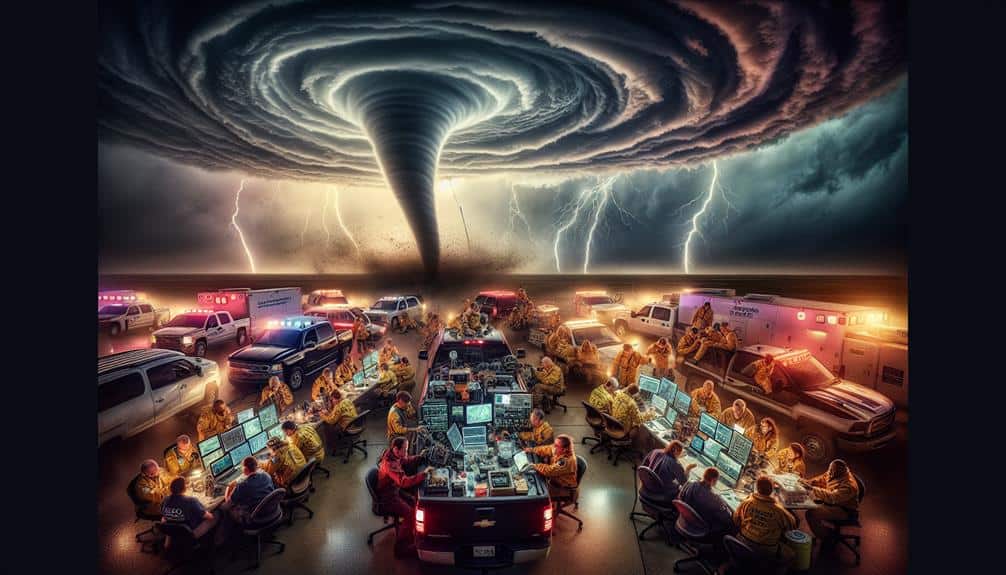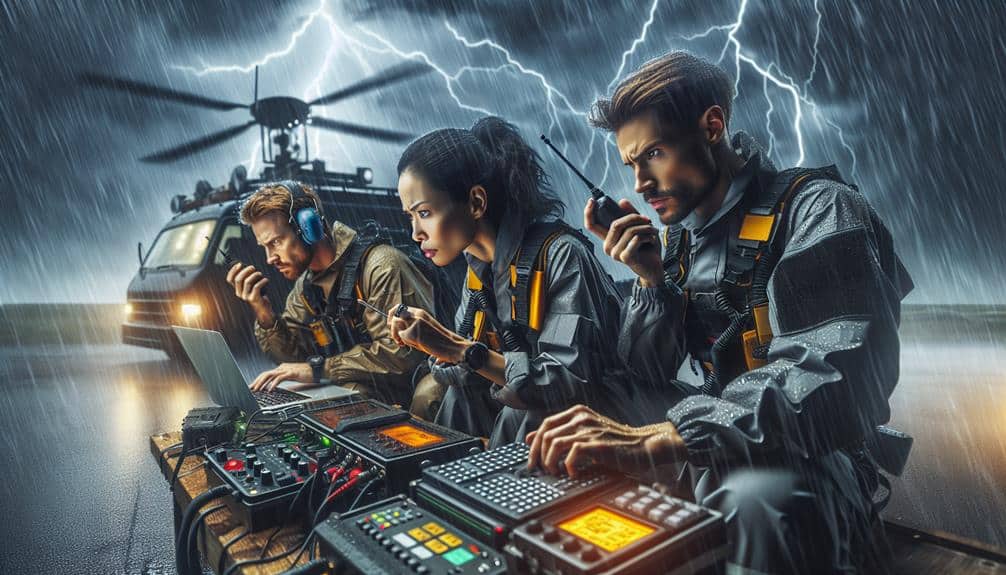To coordinate emergency volunteers effectively, we should utilize multiple communication platforms for swift alerts and clear role assignments with detailed descriptions. Regular training, including simulations, guarantees everyone is prepared. Leveraging technology for automating scheduling and real-time communication is essential. During an emergency, strategic volunteer deployment and prioritizing tasks based on immediate needs maximize impact. Continuous monitoring, feedback collection, and motivation strategies keep volunteers engaged and efficient. If we want to understand the full spectrum of coordinating volunteers during emergencies, there's more to uncover.
Key Points
- Use multiple communication platforms for swift alerts and real-time updates.
- Provide structured role assignments and detailed descriptions to clarify volunteer tasks.
- Conduct regular training and simulation exercises to ensure volunteer readiness.
- Automate scheduling and centralize information to streamline volunteer management.
Effective Communication Channels
Effective communication channels are vital for guaranteeing that emergency volunteers receive timely and accurate information. We can't afford delays or miscommunications when lives are at risk.
Emergency alerts must be swift and clear, so volunteers know precisely what actions to take and when to take them. Utilizing multiple platforms like SMS, email, and push notifications guarantees we reach everyone, regardless of their preferred method of communication.
Volunteer coordination becomes seamless with a robust communication strategy. We need to employ tools that allow for real-time updates and feedback. Apps designed for emergency management facilitate group messaging and task assignments, enabling us to maintain a structured and responsive volunteer force.
It's essential that our communication channels are both reliable and easy to use. This minimizes confusion and maximizes efficiency.
We should also conduct regular training sessions to familiarize volunteers with these communication tools. By doing so, everyone knows how to receive and respond to emergency alerts effectively.
Clear Role Assignments
To complement our strong communication strategy, we must assign clear roles to each volunteer to guarantee everyone knows their specific responsibilities during an emergency. Role clarity is essential to secure seamless team coordination and effective action. When volunteers understand their exact tasks, they can perform with confidence and efficiency, reducing chaos and overlap.
First, we need to define the roles required for the specific emergency scenario. Whether it's logistics, medical aid, or information dissemination, each role must be distinctly outlined. We should create detailed role descriptions that specify duties, reporting lines, and any special skills needed. This approach secures that all team members have a clear understanding of their duties and how their work fits into the broader mission.
Next, we must communicate these roles clearly to our volunteers. Using our established communication channels, we can distribute role assignments and expectations well in advance. This preparation allows volunteers to familiarize themselves with their tasks before they're needed.
Training and Preparedness
Ensuring our volunteers are well-trained and prepared is crucial for effective emergency response. We need to focus on providing extensive training programs that incorporate both theoretical knowledge and practical skills.
Simulation exercises play a pivotal role in this process, allowing volunteers to experience realistic emergency scenarios in a controlled environment. By doing so, they can make quick decisions and act efficiently under pressure.
Hands-on training is another fundamental component. It gives volunteers the opportunity to practice their skills in real-world settings, ensuring they're ready for any situation. From first aid to search and rescue, practical experience is invaluable.
To create a well-rounded training program, we should include:
- Simulation exercises: Realistic drills to build confidence and competence.
- Hands-on training: Practical sessions to practice essential skills.
Utilizing Technology
Let's leverage technology to enhance our volunteer coordination efforts.
By using volunteer management software, real-time communication tools, and effective data collection methods, we can streamline operations and guarantee rapid response.
These technologies will allow us to manage volunteers efficiently, keep everyone informed, and make data-driven decisions.
Volunteer Management Software
In today's digital age, we can streamline volunteer coordination by leveraging sophisticated volunteer management software. These tools are essential in ensuring that we manage volunteer scheduling efficiently and respond swiftly during emergency situations. By integrating technology into our processes, we gain the ability to quickly mobilize and direct our volunteer force, maximizing their impact when it matters most.
Volunteer management software offers several key benefits:
- Automated Volunteer Scheduling: We can easily organize shifts, track availability, and assign roles, ensuring that every volunteer is utilized effectively.
- Centralized Database: Having all volunteer information in one place allows us to quickly access contact details, skills, and past involvement, making it easier to deploy the right people for the right tasks.
Real-Time Communication Tools
Amidst an emergency, real-time communication tools are essential for coordinating volunteers swiftly and effectively. We need to act fast, and tools like instant messaging and video conferencing are our go-to solutions.
Instant messaging platforms enable us to disseminate information rapidly, ensuring that all volunteers receive updates simultaneously. Whether it's assigning tasks or sharing vital information, these tools keep everyone aligned and informed.
Video conferencing allows us to hold virtual meetings, making it possible to discuss strategies and provide training without the need to gather physically. This is particularly valuable when time is of the essence and decisions need to be made quickly.
In addition, social media and mobile apps play a pivotal role in reaching a wider audience. We can post urgent calls for volunteers, updates, and instructions on social media platforms to keep everyone in the loop.
Mobile apps designed for emergency coordination help streamline communications, offering features like push notifications and real-time tracking.
Data Collection Methods
Leveraging real-time communication tools, we can also efficiently gather and analyze data from volunteers to optimize our emergency response efforts. By utilizing technology, we streamline the collection of critical information, ensuring our decisions are data-driven and timely. The use of digital platforms allows us to conduct survey analyses quickly, capturing volunteers' experiences and feedback right after tasks are completed.
Field observations are another pivotal method. With mobile apps, volunteers can document their on-ground experiences in real-time, providing us with immediate insights into the situation. This not only improves situational awareness but also helps in adjusting our strategies on the fly.
To illustrate, here are some effective data collection methods:
- Survey Analysis: Deploying online surveys to gather feedback on volunteer experiences and operational efficiency.
- Field Observations: Utilizing mobile apps for volunteers to report observations and incidents as they occur.
Resource Allocation

Effective resource distribution guarantees that volunteers are deployed where they're most needed during emergencies. We achieve this through strategic volunteer deployment and resource optimization. By evaluating the situation on the ground and understanding the immediate needs, we can direct our resources to the areas that require the most attention. This approach assures that every volunteer's effort counts and that no resources are wasted.
Task prioritization is vital for a rapid response. When emergencies strike, we can't afford to waste time. We need to quickly identify and prioritize tasks to make sure that the most critical needs are addressed first. This involves a clear understanding of the emergency's scope, the available resources, and the skill sets of our volunteers. By doing so, we can guarantee that our response is both swift and effective.
We also need to continuously review our resource allocation strategy. This means being flexible and ready to adjust our plans as the situation evolves. Our goal is to maintain a high level of efficiency and effectiveness, ensuring that our volunteers are always in the right place at the right time. In doing so, we maximize our impact and help those in need more effectively.
Monitoring and Feedback
To guarantee our operations remain efficient, we need to continuously monitor volunteer activities and gather feedback. By doing so, we can track performance, identify areas for improvement, and make necessary adjustments in real-time. Effective monitoring ensures that our volunteers are meeting their objectives and adhering to defined protocols.
When it comes to feedback collection, we should establish multiple channels to make it easy for volunteers to share their experiences and suggestions. Regular performance tracking helps us understand how well volunteers are performing their tasks and where they might need additional support or training.
To streamline the process, we can implement several strategies:
- Surveys and Questionnaires: Periodic surveys allow us to gather structured feedback quickly. This method is particularly useful for identifying common challenges and areas of concern.
- Direct Observations: Supervisors or coordinators can observe volunteer activities firsthand. This direct approach provides immediate insights and the opportunity to address issues on the spot.
Volunteer Motivation Strategies

Engaging volunteers effectively requires us to understand and implement diverse motivation strategies. We need to ensure our volunteers feel valued and connected to the mission. Recognition programs and incentives are essential. Simple gestures like public acknowledgment, certificates of appreciation, or small rewards can make a significant difference. They show our volunteers that their efforts don't go unnoticed.
In addition to recognition, we must foster a sense of community among our volunteers. Team building activities and bonding exercises are important. They don't just promote camaraderie but also improve teamwork and communication. When volunteers feel connected to each other, they're more likely to stay committed and perform better in high-stress situations.
It's also important to provide clear goals and regular feedback. Volunteers should know exactly how their contributions impact the overall mission. This clarity boosts their sense of purpose and motivation.
Frequently Asked Questions
How Can We Ensure Volunteer Safety During an Emergency?
We can guarantee volunteer safety during an emergency by implementing robust training protocols and clear communication plans. Let's equip everyone with the necessary skills and information, so they can act confidently and stay safe while helping others.
What Legal Considerations Should Be Taken Into Account for Volunteer Coordination?
We must prioritize legal compliance and liability management. Ensuring volunteers have proper training, clear roles, and signed waivers helps mitigate risks. Let's stay informed about local laws to protect both our volunteers and our organization.
How Do We Manage Cultural Differences Among Volunteers?
Steering cultural differences is like guiding a ship through diverse waters. We embrace cultural sensitivity and prioritize volunteer training. Clear communication and team building guarantee harmony, empowering us to work together freely and effectively.
What Are the Best Practices for Recruiting Emergency Volunteers?
We should prioritize volunteer training and diverse recruitment methods. Engaging local communities through social media, partnerships, and events secures we attract dedicated individuals. Clear communication and offering flexible roles will empower and retain our emergency volunteers.
How Can We Handle Conflicts or Misunderstandings Among Volunteers?
Handling conflicts among volunteers is like walking a tightrope during a hurricane. We need solid conflict resolution and clear communication strategies to guarantee harmony. Let's address issues immediately, foster open dialogue, and encourage mutual respect.


